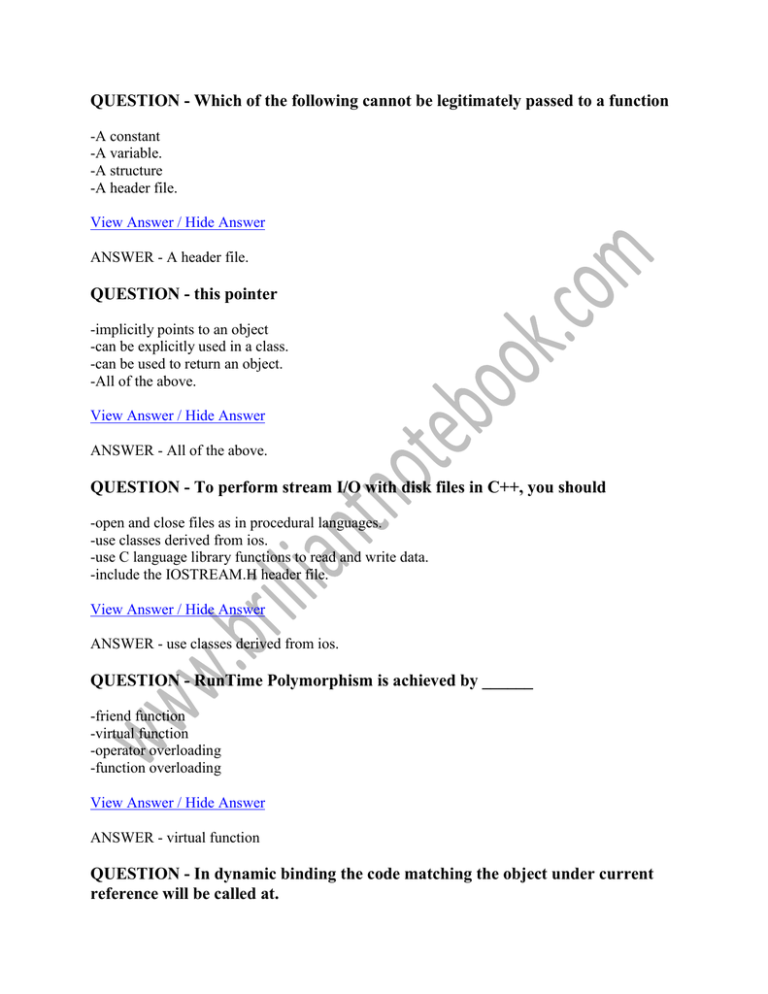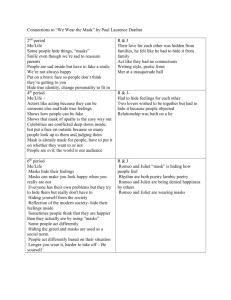QUESTION - this pointer
advertisement

QUESTION - Which of the following cannot be legitimately passed to a function -A constant -A variable. -A structure -A header file. View Answer / Hide Answer ANSWER - A header file. QUESTION - this pointer -implicitly points to an object -can be explicitly used in a class. -can be used to return an object. -All of the above. View Answer / Hide Answer ANSWER - All of the above. QUESTION - To perform stream I/O with disk files in C++, you should -open and close files as in procedural languages. -use classes derived from ios. -use C language library functions to read and write data. -include the IOSTREAM.H header file. View Answer / Hide Answer ANSWER - use classes derived from ios. QUESTION - RunTime Polymorphism is achieved by ______ -friend function -virtual function -operator overloading -function overloading View Answer / Hide Answer ANSWER - virtual function QUESTION - In dynamic binding the code matching the object under current reference will be called at. -Compile time -Run time -Editing time -Binding time View Answer / Hide Answer ANSWER - Run time QUESTION - Following are the object oriented programming language -JAVA -C++ -Small talk -All of above View Answer / Hide Answer ANSWER - All of above QUESTION - How many characters are recognized by ANSI C++? -32 -64 -no limit -none of these View Answer / Hide Answer ANSWER - no limit QUESTION - Inheritance is the process by which -Object of one class acquires the properties of objects of another class -Variable of one class acquires the properties of variable of another class -Object of one class acquires the properties of objects of same class -Variable of one class acquires the properties of objects of another class View Answer / Hide Answer ANSWER - Object of one class acquires the properties of objects of another class QUESTION - Class members are by default -Public -Private -Protected -Inherited View Answer / Hide Answer ANSWER - Private QUESTION - How many words can be read by cin? -one -Two -Three -Four View Answer / Hide Answer ANSWER - one QUESTION - A function that is called automatically when an object is created is called as -constant -constructor -static -friend View Answer / Hide Answer ANSWER - constructor QUESTION - The null character will take space of -0 byte -2 byte -1 byte -8 byte View Answer / Hide Answer ANSWER - 1 byte QUESTION - This operator is used to allocate memory -new -delete -static -real View Answer / Hide Answer ANSWER - new QUESTION - Which one is correct to declare an interface in a class? -By making all the methods pure virtual in a class -By making all the methods abstract using the keyword abstract in a class -By declaring the class as interface with the keyword interface -It is not possible to create interface class in C++ View Answer / Hide Answer ANSWER - By making all the methods pure virtual in a class QUESTION - Keywords support dynamic method of resolution is -abstract -Virtual -Dynamic -Typeid View Answer / Hide Answer ANSWER - Virtual QUESTION - Which pointer is implicit pointer passed as the first argument for non-static member functions? -self pointer -std::auto_ptr pointer -Myself pointer -this pointer View Answer / Hide Answer ANSWER - this pointer QUESTION - Inventor of C++ language is -John Dell -Bjarne Stroustrup -Thomusn Steve -Karl Thomus View Answer / Hide Answer ANSWER - Bjarne Stroustrup QUESTION - Destructor can have following number of argument -2 -1 -0 View Answer / Hide Answer ANSWER - 0 C++ interview questions contributed - April 06, 2013 at 15:00 PM by Kshipra Singh 1. Explain abstraction. - Simplified view of an object in user’s language is called abstraction. - It is the simplest, well-defined interface to an object in OO and C++ that provides all the expected features and services to the user in a safe and predictable manner. - It provides all the information that the user requires. - Good domain knowledge is important for effective abstraction. - It separates specifications from implementation & keeps the code simpler and more stable. 2. a.) What is the real purpose of class – to export data? No, the real purpose of a class is not to export data. Rather, it is to provide services. Class provides a way to abstract behaviour rather than just encapsulating the bits. b.) What things would you remember while making a interface? - A class’s interface should be sensible enough. It should behave the way user expects it to. - It should be designed from the outside in. 3. Explain the benefits of proper inheritance. The biggest benefits of proper inheritance are : a.) substitutability and b.) extensibility. Substitutability – The objects of a properly derived class can be easily and safely substituted for an object of its base class. Extensibility – The properly derived class can be freely and safely used in place of its base class even if the properly derived class is created a lot later than defining the user code. Extending the functionalities of a system is much easier when you add a properly derived class containing enhanced functionalities. 4. Does improper inheritance have a potential to wreck a project? Many projects meet a dead end because of bad inheritance. So, it certainly has the potential to wreck a project. Small projects still have a scope to avoid the complete consequence of bad inheritance if the developers communicate and co-ordinate with an easy system design. This kind of a luxury is not possible in big projects, which means that the code breaks in a way difficult and at times impossible way to fix it. 5. How should runtime errors be handled in C++? - The runtime errors in C++ can be handled using exceptions. - This exception handling mechanism in C++ is developed to handle the errors in software made up of independently developed components operating in one process and under synchronous control. - According to C++, any routine that does not fulfil its promise throws an exception. The caller who knows the way to handle these exceptions can catch it. 6. When should a function throw an exception? A function should throw an exception when it is not able to fulfil its promise. As soon as the function detects a problem that prevents it from fulfilling its promise, it should throw an exception. If the function is able to handle the problem, recover itself and deliver the promise, the exception should not be thrown. If an event happens very frequently then exception handling is not the best way to deal with it. It requires proper fixation. 7. Where are setjmp and longjmp used in C++? -Setjmp and longjmp should not be used in C++. - Longjmp jumps out of the function without unwinding the stack. This means that the local objects generated are not destructed properly. - The better option is to use try/catch/throw instead. They properly destruct the local objects. 8. Are there ant special rules about inlining? Yes, there are a few rules about inlining – a.) Any source files that used the inline function must contain the function’s definition. b.) An inline function must be defined everywhere. The easier way to deal with this to define the function once in the class header file and include the definition as required. The harder way is to redefine the function everywhere and learn the one-definition rule. c.) Main() can not be inline. 9. Explain one-definition rule (ODR). According to one-definition rule, C++ constructs must be identically defined in every compilation unit they are used in. As per ODR, two definitions contained in different source files are called to be identically defined if they token-for-token identical. The tokens should have same meaning in both source files. Identically defined doesn’t mean character-by-character equivalence. Two definitions can have different whitespace or comments and yet be identical. 10. What are the advantages of using friend classes? - Friend classes are useful when a class wants to hide features from users which are needed only by another, tightly coupled class. - Implementation details can be kept safe by providing friend status to a tightly cohesive class. 11. What is the use of default constructor? - It is a constructor that does not accept any parameters. - If there is no user-defined constructor for a class, the compiler declares a default parameterless constructor called default constructor. It is an inline public member of its class. When the compiler uses this constructor to create an object – the constructor will have no constructor initializer and a null body. 12. Differentiate between class and structure. - The members of structures are public while those of a class are private. - Classes provide data hiding while structures don’t. - Class bind both data as well as member functions while structures contain only data. 13. Explain container class. -Class to hold objects in memory or external storage. It acts as a generic holder. - It has a predefined behaviour and a known interface. - It is used to hide the topology used for maintaining the list of objects in memory. The container class can be of two types: - Heterogeneous container – Here the container class contains a group of mixed objects - Homogeneous container - Here the container contains all the same objects. 14. a.) What is namespace? - Namespaces are used to group entities like classes, objects and functions under a name. b.) Explain explicit container. - These are constructors that cannot take part in an implicit conversion. - These are conversion constructors declared with explicit keyword. - Explicit container is reserved explicitly for construction. It is not used by the compiler to implement an implied conversion of types. 15. Explain class invariant. - It is a condition that ensures correct working of a class and defines all the valid states for an object. - When an object is created class invariants must hold. - It is necessary for them to be preserved under all operations of the class. - All class invariants are both preconditions as well as post-conditions for all operations or member functions of the class. 16. Differentiate between late binding and early binding. What are the advantages of early binding? a.) Late binding refers to function calls that are not resolved until run time while early binding refers to the events that occur at compile time. b.) Late binding occurs through virtual functions while early binding takes place when all the information needed to call a function is known at the time of compiling. Early binding increases the efficiency. Some of the examples of early binding are normal function calls, overloaded function calls, and overloaded operators etc. 17. Explain public, protected, private in C++? These are three access specifiers in C++. - Public – Here the data members and functions are accessible outside the class. - Protected - Data members and functions are available to derived classes only. - Private - Data members and functions are not accessible outside the class.





